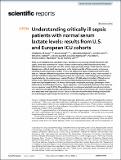Understanding critically ill sepsis patients with normal serum lactate levels: results from U.S. and European ICU cohorts
Author(s)
Sauer, Christopher M.; Gómez, Josep; Botella, Manuel Ruiz; Ziehr, David R.; Oldham, William M.; Gavidia, Giovana; Rodríguez, Alejandro; Elbers, Paul; Girbes, Armand; Bodi, Maria; Celi, Leo Anthony; ... Show more Show less
Downloads41598-021-99581-6.pdf (1.175Mb)
Publisher with Creative Commons License
Publisher with Creative Commons License
Creative Commons Attribution
Terms of use
Metadata
Show full item recordAbstract
Abstract While serum lactate level is a predictor of poor clinical outcomes among critically ill patients with sepsis, many have normal serum lactate. A better understanding of this discordance may help differentiate sepsis phenotypes and offer clues to sepsis pathophysiology. Three intensive care unit datasets were utilized. Adult sepsis patients in the highest quartile of illness severity scores were identified. Logistic regression, random forests, and partial least square models were built for each data set. Features differentiating patients with normal/high serum lactate on day 1 were reported. To exclude that differences between the groups were due to potential confounding by pre-resuscitation hyperlactatemia, the analyses were repeated for day 2. Of 4861 patients included, 47% had normal lactate levels. Patients with normal serum lactate levels had lower 28-day mortality rates than those with high lactate levels (17% versus 40%) despite comparable physiologic phenotypes. While performance varied between datasets, logistic regression consistently performed best (area under the receiver operator curve 87–99%). The variables most strongly associated with normal serum lactate were serum bicarbonate, chloride, and pulmonary disease, while serum sodium, AST and liver disease were associated with high serum lactate. Future studies should confirm these findings and establish the underlying pathophysiological mechanisms, thus disentangling association and causation.
Date issued
2021-10-08Department
Harvard--MIT Program in Health Sciences and Technology. Laboratory for Computational Physiology; Massachusetts Institute of Technology. Institute for Medical Engineering & SciencePublisher
Springer Science and Business Media LLC
Citation
Sauer, C.M., Gómez, J., Botella, M.R. et al. Understanding critically ill sepsis patients with normal serum lactate levels: results from U.S. and European ICU cohorts. Sci Rep 11, 20076 (2021)
Version: Final published version
ISSN
2045-2322